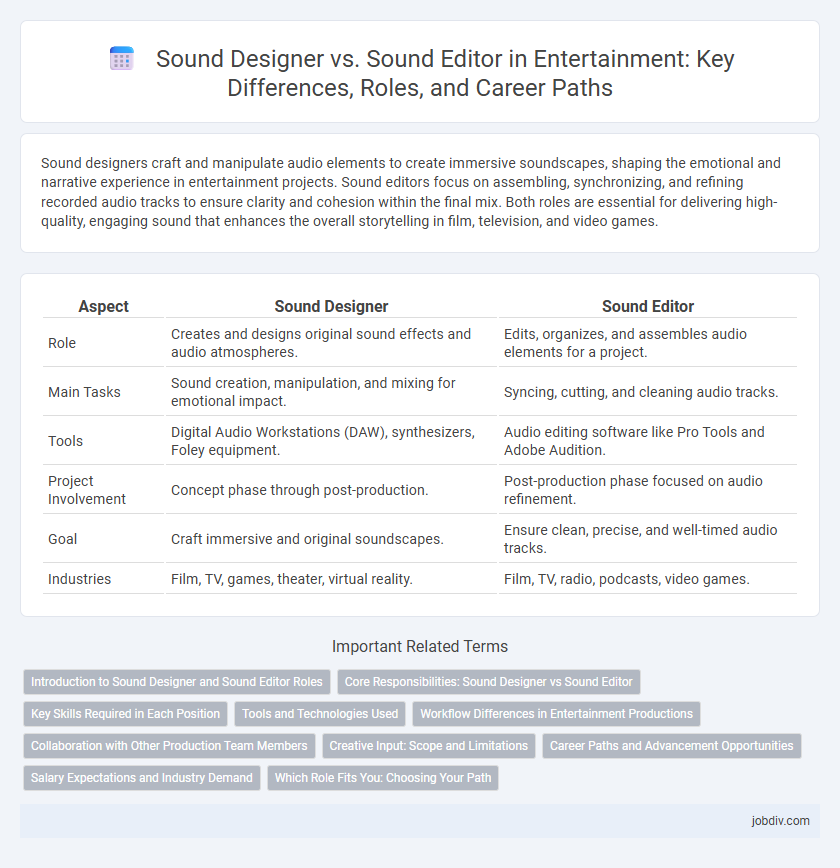Sound designers craft and manipulate audio elements to create immersive soundscapes, shaping the emotional and narrative experience in entertainment projects. Sound editors focus on assembling, synchronizing, and refining recorded audio tracks to ensure clarity and cohesion within the final mix. Both roles are essential for delivering high-quality, engaging sound that enhances the overall storytelling in film, television, and video games.
Table of Comparison
| Aspect | Sound Designer | Sound Editor |
|---|---|---|
| Role | Creates and designs original sound effects and audio atmospheres. | Edits, organizes, and assembles audio elements for a project. |
| Main Tasks | Sound creation, manipulation, and mixing for emotional impact. | Syncing, cutting, and cleaning audio tracks. |
| Tools | Digital Audio Workstations (DAW), synthesizers, Foley equipment. | Audio editing software like Pro Tools and Adobe Audition. |
| Project Involvement | Concept phase through post-production. | Post-production phase focused on audio refinement. |
| Goal | Craft immersive and original soundscapes. | Ensure clean, precise, and well-timed audio tracks. |
| Industries | Film, TV, games, theater, virtual reality. | Film, TV, radio, podcasts, video games. |
Introduction to Sound Designer and Sound Editor Roles
Sound designers create and manipulate audio elements to craft immersive soundscapes and enhance the emotional impact of visual media. Sound editors focus on assembling, synchronizing, and refining recorded audio, ensuring clarity and cohesion within the final production. Both roles collaborate closely to deliver a seamless auditory experience in films, games, and television.
Core Responsibilities: Sound Designer vs Sound Editor
Sound designers create and manipulate audio elements to craft an immersive soundscape that enhances the emotional and narrative impact of a production, focusing on original sound creation, effects, and ambiance. Sound editors concentrate on organizing, assembling, and refining audio tracks, ensuring synchronization, clarity, and consistency within dialogue, sound effects, and background noise. Both roles collaborate closely to achieve a cohesive auditory experience, with designers emphasizing creativity and editors prioritizing technical precision.
Key Skills Required in Each Position
Sound designers require expertise in acoustic theory, creative audio manipulation, and proficiency with digital audio workstations (DAWs) to craft unique auditory experiences. Sound editors focus on precise audio editing, synchronization, noise reduction, and maintaining continuity across dialogue, effects, and music layers using software such as Pro Tools. Both roles demand attention to detail, strong listening skills, and collaboration within post-production teams to enhance the overall soundscape of film, television, and gaming projects.
Tools and Technologies Used
Sound designers utilize advanced digital audio workstations (DAWs) like Pro Tools, Logic Pro, and Ableton Live to create and manipulate soundscapes, incorporating synthesizers, samplers, and modular systems for innovative audio effects. Sound editors focus on precise audio editing with specialized software such as Avid Pro Tools, Adobe Audition, and Izotope RX, emphasizing noise reduction, dialogue syncing, and sound cleanup. Both roles integrate tools like Foley recording equipment, field recorders, and immersive audio formats (e.g., Dolby Atmos) to enhance the auditory experience in film, television, and video games.
Workflow Differences in Entertainment Productions
Sound designers primarily create and manipulate audio elements to establish the overall auditory atmosphere of entertainment productions, while sound editors focus on assembling, synchronizing, and refining these audio components within the timeline. Sound designers often experiment with sound synthesis and effects during pre-production, contrasting with sound editors who work meticulously during post-production to ensure seamless integration and clarity of dialogue, Foley, and background sounds. This workflow distinction underscores a collaborative yet distinct division where sound designers innovate and shape sounds, and sound editors polish and synchronize them for the final mix.
Collaboration with Other Production Team Members
Sound designers and sound editors collaborate closely with directors, producers, and composers to shape the auditory experience of a project. Sound designers create original audio elements and textures, while sound editors assemble, synchronize, and refine these sounds to fit the narrative flow. This teamwork ensures seamless integration of sound effects, dialogue, and music, enhancing the overall storytelling and emotional impact in film, television, and gaming.
Creative Input: Scope and Limitations
Sound designers craft original audio elements, shaping the auditory atmosphere with innovative effects and textures to enhance storytelling. Sound editors focus on assembling, refining, and syncing existing audio clips, ensuring clarity and cohesiveness within the narrative. The creative input of sound designers typically involves conceptualization and creation, while sound editors emphasize precision and technical adjustment within set parameters.
Career Paths and Advancement Opportunities
Sound designers often begin their careers in smaller studios or independent projects, focusing on creating original audio elements and immersive soundscapes, which positions them for advancement into lead design roles or audio direction. Sound editors typically start with technical editing tasks such as syncing dialogue and cleaning audio in post-production, providing a pathway to senior editing positions or supervising sound editor roles on larger film and television projects. Both careers offer opportunities to specialize in gaming, film, or virtual reality, with advancement depending on technical skills, creative vision, and industry networking.
Salary Expectations and Industry Demand
Sound designers typically command higher salaries than sound editors due to their creative role in crafting unique audio experiences, with average earnings ranging from $60,000 to $90,000 annually. Sound editors, essential for assembling and refining audio tracks, usually earn between $45,000 and $70,000 per year, reflecting steady industry demand in film, television, and gaming sectors. Growing demand for immersive soundscapes in virtual reality and multimedia projects is increasing opportunities and salary potential for both sound designers and editors.
Which Role Fits You: Choosing Your Path
Sound designers craft original audio elements and immersive soundscapes, ideal for creatives passionate about shaping auditory experiences from scratch. Sound editors specialize in selecting, refining, and synchronizing audio clips, perfect for detail-oriented individuals who excel in precision and timing. Choosing between these roles depends on whether you prefer creative sound creation or meticulous audio assembly within entertainment productions.
Sound Designer vs Sound Editor Infographic

 jobdiv.com
jobdiv.com